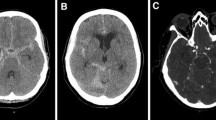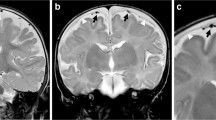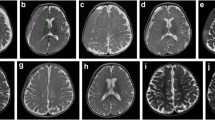Abstract
We present an infant with macrocrania, who initially demonstrated prominent extra-axial fluid collections on sonography of the brain, compatible with benign infantile hydrocephalus (BIH). Because of increasing macrocrania, a follow-up sonogram of the brain was performed; it revealed progressive enlargement of the extra-axial spaces, which now had echogenic debris. Color Doppler US showed bridging veins traversing these extra-axial spaces, so it was initially thought that these spaces were subarachnoid in nature (positive cortical vein sign). However, an arachnoid membrane was identified superior to the cortex, and there was compression of true cortical vessels beneath this dural membrane. An MRI of the brain showed the extra-axial spaces to represent bilateral subdural hematomas. The pathogenesis of spontaneous development of the subdural hematomas, in the setting of BIH, is discussed. We also emphasize that visualizing traversing bridging veins through extra-axial spaces does not necessarily imply that these spaces are subarachnoid in origin.




Similar content being viewed by others
References
Babcock D, Han B, Dine M (1988) Sonographic findings in infants with macrocrania. AJR 150:1359–1365
Mori K, Sakamoto T, Nishimura K, et al (1993) Subarachnoid fluid collection in infants complicated by subdural hematoma. Childs Nerv Syst 9:282–284
McCluney K, Ueakley J, Festermacher M, et al (1992) Subdural hygroma versus atrophy on MR brain scans: “the cortical vein sign.” AJNR 13:1335–1339
Chen C, Chou T, Zimmerman R, et al (1996) Pericerebral fluid collection: differentiation of enlarge subarachnoid spaces from subdural collections with color Doppler US. Radiology 201:389–392
Swift D, McBride L (2000) Chronic subdural hematoma in children. Neurosurg Clin N Am 11:439–443
Swischuck L (2004) Imaging of the newborn, infant, and young child, 5th edn. Lippincott Williams and Wilkins, p 993
Ravid S, Maytal J (2003) External hydrocephalus: a probable cause for subdural hematoma in infancy. Pediatr Neurol 28:139–141
Papasian NC, Frim DM (2000) A theoretical model of benign external hydrocephalus that predicts a predisposition toward extra-axial hemorrhage after minor head trauma. Pediatr Neurosurg 33:188–193
Nakamura S (1989) Extraction of angiogenesis factor from chronic subdural hematomas. Significance in capsule formation and hematoma growth. Brain Inj 3:129–136
Yamashima T, Yamamoto S (1984) How do vessels proliferate in the capsule of a chronic subdural hematoma? Neurosurgery 15:672–678
Author information
Authors and Affiliations
Corresponding author
Rights and permissions
About this article
Cite this article
Amodio, J., Spektor, V., Pramanik, B. et al. Spontaneous development of bilateral subdural hematomas in an infant with benign infantile hydrocephalus: color Doppler assessment of vessels traversing extra-axial spaces. Pediatr Radiol 35, 1113–1117 (2005). https://doi.org/10.1007/s00247-005-1503-x
Received:
Revised:
Accepted:
Published:
Issue Date:
DOI: https://doi.org/10.1007/s00247-005-1503-x




